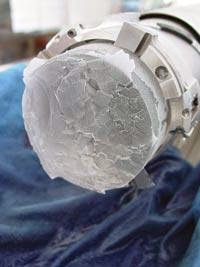
Analysis of data collected from ice cores and marine sediment cores in both polar regions has given scientists a clearer picture of how the Earth’s climate changed during the last Interglacial period. This comparatively warm time period occurred between 130,000 and 115,000 years ago.
By lining up the records, and establishing a common chronology, Dr Emilie Capron, from British Antarctic Survey, concluded that Antarctica was a few degrees warmer than it is today and that the Southern Hemisphere warmed earlier than the Northern Hemisphere.
Results from her findings have been presented to the European Geosciences Union General Assembly in Vienna, Austria this week (27th April – 2nd May 2014).
Dr. Capron said: “To understand our changing climate we need to go back in time. Past warm periods, called interglacials, are particularly interesting because they provide insights as to how current natural changes may interact with those originating from human influences.”
The results, which have been submitted to a science journal for publication, will help climate modellers predict future climate change. Questions remain about the contribution Antarctic and Greenland glaciers may make towards sea level rise.
Dr Capron’s results not only confirm the last interglacial period was warmer than today but also that surface temperature peaks weren’t uniform across the globe.
Data from more than forty cores were examined as part of the research project.
The work is part of a broad ranging interdisciplinary programme, the iGlass consortium, which integrates new field data, data synthesis and numerical modelling, in order to study the response of ice volume and sea level to different climatic states during the last five interglacial periods.
Over the last 1 million years, the Earth’s climate has alternated between warm interglacial periods and cold glacial periods characterised by the growth of ice sheets in the northern hemisphere. Interglacials re-occur roughly every 100,000 years between ice ages. The present interglacial began around 10,000 years ago and has been relatively stable since then.
Note : The above story is based on materials provided by British Antarctic Survey










